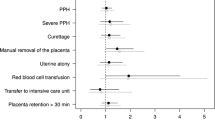Abstract
Purpose
Oxytocin donation in caesarean section is used to reduce postpartum blood loss. Cardiovascular side effects such as tachycardia, hypotension and decreased cardiac output are known and seem to depend on the way of application, whereas the blood loss is said to be similar. We aimed to examine that extent of haemorrhage in our own patients.
Method
In July 2011, the perioperative oxytocin management was changed and the postpartum was oxytocin bolus abolished. Retrospectively, we reviewed the pre- and postpartum haemoglobin in all women who had undergone caesarean section in the year 2011 at the University Hospital of Schleswig-Holstein, Campus Luebeck.
Results
We found a significantly higher blood loss in those patients who were treated without oxytocin bolus but only with oxytocin infusion (−10.5 vs. −9 g/dl).
Conclusion
We recommend to do further studies to clarify the advantage and contraindications of using oxytocin boluses and until to use the oxytocin bolus again in healthy patients but to avoid it in patients with cardiovascular risk.

Similar content being viewed by others
References
King KJ, Douglas MJ, Unger W, Wong A, King RA (2010) Five unit bolus oxytocin at cesarean delivery in women at risk of atony: a randomized, double-blind, controlled trial. Anesth Analg 111(6):1460–1466
Murphy DJ, MacGregor H, Munishankar B, McLeod G (2009) A randomised controlled trial of oxytocin 5 IU and placebo infusion versus oxytocin 5 IU and 30 IU infusion for the control of blood loss at elective caesarean section–pilot study. Eur J Obstet Gynecol Reprod Biol 142(1):30–33
Sheehan SR, Montgomery AA, Carey M, McAuliffe FM, Eogan M, Gleeson R, Geary M, Murphy DJ, ECSSIT Study Group (2011) Oxytocin bolus versus oxytocin bolus and infusion for control of blood loss at elective caesarean section: double blind, placebo controlled, randomised trial. BMJ 1(343):d4661
Hendricks CH, Brenner WE (1970) Cardiovascular effects of oxytocin drugs used post partum. Am J Obstet Gynecol 108:751–760
Palmer CM, Norris MC, Giudici MC et al (1990) Incidence of electrocardiographic changes during caesarean delivery under regional anesthesia. Anesth Analg 70:36–43
Svanström MC, Biber B, Hanes M, Johansson G, Näslund U, Balfors EM (2008) Signs of myocardial ischaemia after injection of oxytocin: a randomized double-blind comparison of oxytocin and methylergometrine during Caesarean section. Br J Anaesth 100:683–689
Jonsson M, Hanson U, Lidell C, Nordén-Lindeberg S (2010) ST depression at caesarean section and the relation to oxytocin dose. A randomised controlled trial. BJOG 117(1):76–83
Mathew JP, Fleisher LA, Rinehouse JA et al (1992) ST segment depression during labour and delivery. Anesthesiology 77:635–641
McLintic AJ, Pringle SD, Lilley S et al (1992) Electrocardiographic changes during caesarean section under regional anesthesia. Anesth Analg 74:51–56
Pinder AJ, Dresner M, Calow C, O’Riordan J, Johnson R (2002) Haemodynamic changes caused by oxytocin during caesarean section under spinal anaesthesia. Int J Obstet Anesth 11:156–159
Weis FR Jr, Markello R, Mo B, Bochiechio P (1975) Cardiovascular effects of oxytocin. Obstet Gynecol 46:211–214
Thomas JS, Koh SH, Cooper GM (2007) Haemodynamic effects of oxytocin given as i.v. bolus or infusion on women undergoing Caesarean section. BJA 98(1):116–119
Thomas TA, Cooper GM, Editorial Board of the Confidential Enquiries into Maternal Deaths in the United Kingdom (2002) Maternal deaths from anaesthesia. An extract from why mothers die 1997–1999, the confidential enquiries into maternal deaths in the United Kingdom. Br J Anaesth 89(3):499–508
National Collaborating Centre for Women’s and Children’s Health (1900) Caesarean section clinical guideline 2004. Royal College of Obstetricians and Gynaecologists’ Press, London, vol 12, p 11
Schuurmans N, MacKinnon C, Lane C, Etches D (2000) Society of Obstetricians and Gynaecologists of Canada clinical practice guidelines: prevention and management of postpartum haemorrhage. J SOCG 88:1–11
Conflict of interest
We declare that we have no conflict of interest.
Author information
Authors and Affiliations
Corresponding author
Rights and permissions
About this article
Cite this article
Pursche, T., Diedrich, K. & Banz-Jansen, C. Blood loss after caesarean section: depending on the management of oxytocin application?. Arch Gynecol Obstet 286, 633–636 (2012). https://doi.org/10.1007/s00404-012-2334-2
Received:
Accepted:
Published:
Issue Date:
DOI: https://doi.org/10.1007/s00404-012-2334-2




